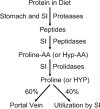Proline and hydroxyproline metabolism: implications for animal and human nutrition
- PMID: 20697752
- PMCID: PMC3773366
- DOI: 10.1007/s00726-010-0715-z
Proline and hydroxyproline metabolism: implications for animal and human nutrition
Abstract
Proline plays important roles in protein synthesis and structure, metabolism (particularly the synthesis of arginine, polyamines, and glutamate via pyrroline-5-carboxylate), and nutrition, as well as wound healing, antioxidative reactions, and immune responses. On a per-gram basis, proline plus hydroxyproline are most abundant in collagen and milk proteins, and requirements of proline for whole-body protein synthesis are the greatest among all amino acids. Therefore, physiological needs for proline are particularly high during the life cycle. While most mammals (including humans and pigs) can synthesize proline from arginine and glutamine/glutamate, rates of endogenous synthesis are inadequate for neonates, birds, and fish. Thus, work with young pigs (a widely used animal model for studying infant nutrition) has shown that supplementing 0.0, 0.35, 0.7, 1.05, 1.4, and 2.1% proline to a proline-free chemically defined diet containing 0.48% arginine and 2% glutamate dose dependently improved daily growth rate and feed efficiency while reducing concentrations of urea in plasma. Additionally, maximal growth performance of chickens depended on at least 0.8% proline in the diet. Likewise, dietary supplementation with 0.07, 0.14, and 0.28% hydroxyproline (a metabolite of proline) to a plant protein-based diet enhanced weight gains of salmon. Based on its regulatory roles in cellular biochemistry, proline can be considered as a functional amino acid for mammalian, avian, and aquatic species. Further research is warranted to develop effective strategies of dietary supplementation with proline or hydroxyproline to benefit health, growth, and development of animals and humans.
Figures





References
-
- Aksnes A, Mundheim H, Toppe J, et al. The effect of dietary hydroxyproline supplementation on salmon (Salmo salar L.) fed high plant protein diets. Aquaculture. 2006;275:242–249.
-
- Austic RE. Nutritional and metabolic interrelationships of arginine, glutamic acid and proline in the chicken. Fed Proc. 1976;35:1914–1916. - PubMed
-
- Baker DH. Advances in protein-amino acid nutrition of poultry. Amino Acids. 2009;37:29–41. - PubMed
-
- Ball RO, Atkinson JL, Bayley HS. Proline as an essential amino acid for the young pig. Br J Nutr. 1986;55:659–668. - PubMed
-
- Barbul A. Proline precursors to sustain mammalian collagen synthesis. J Nutr. 2008;138:2021S–2024S. - PubMed
Publication types
MeSH terms
Substances
Grants and funding
LinkOut - more resources
Full Text Sources
Other Literature Sources

